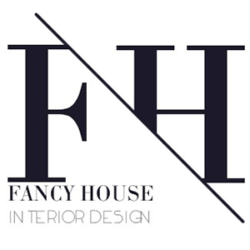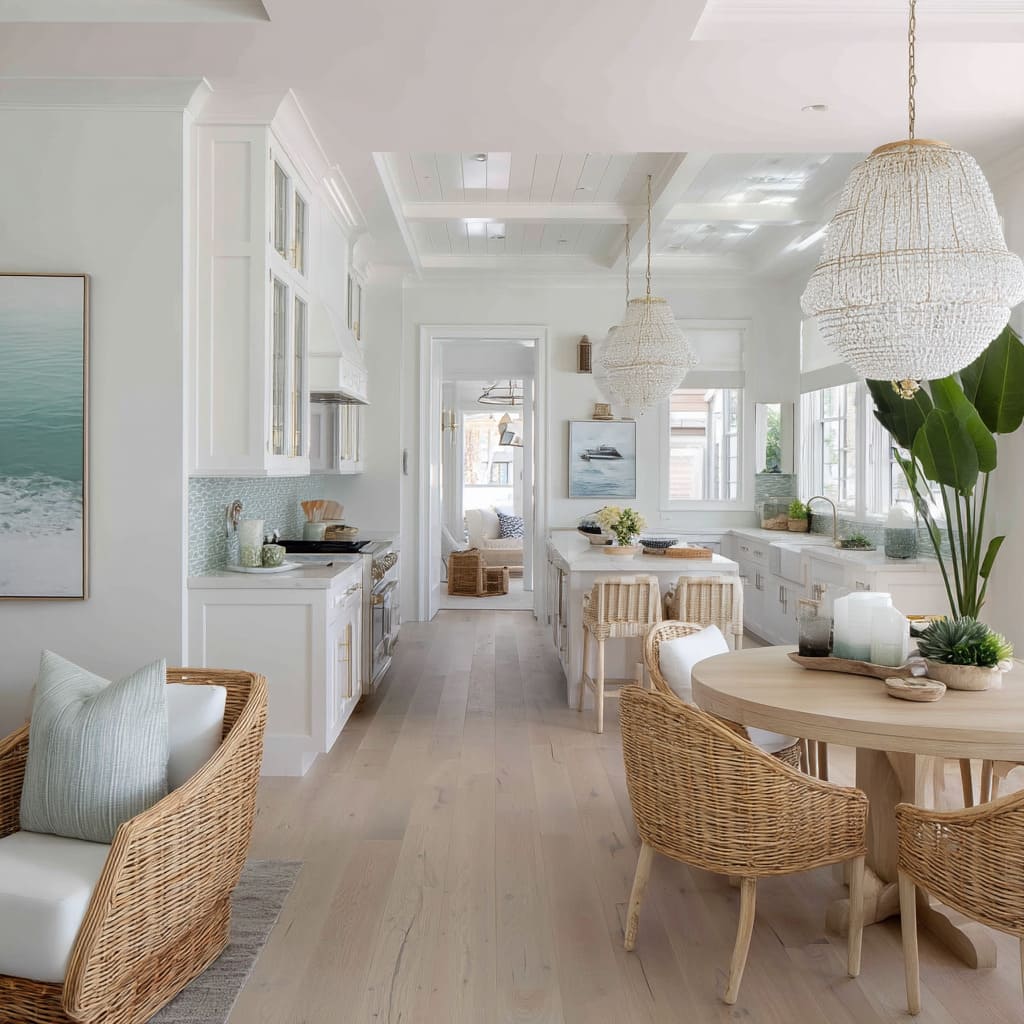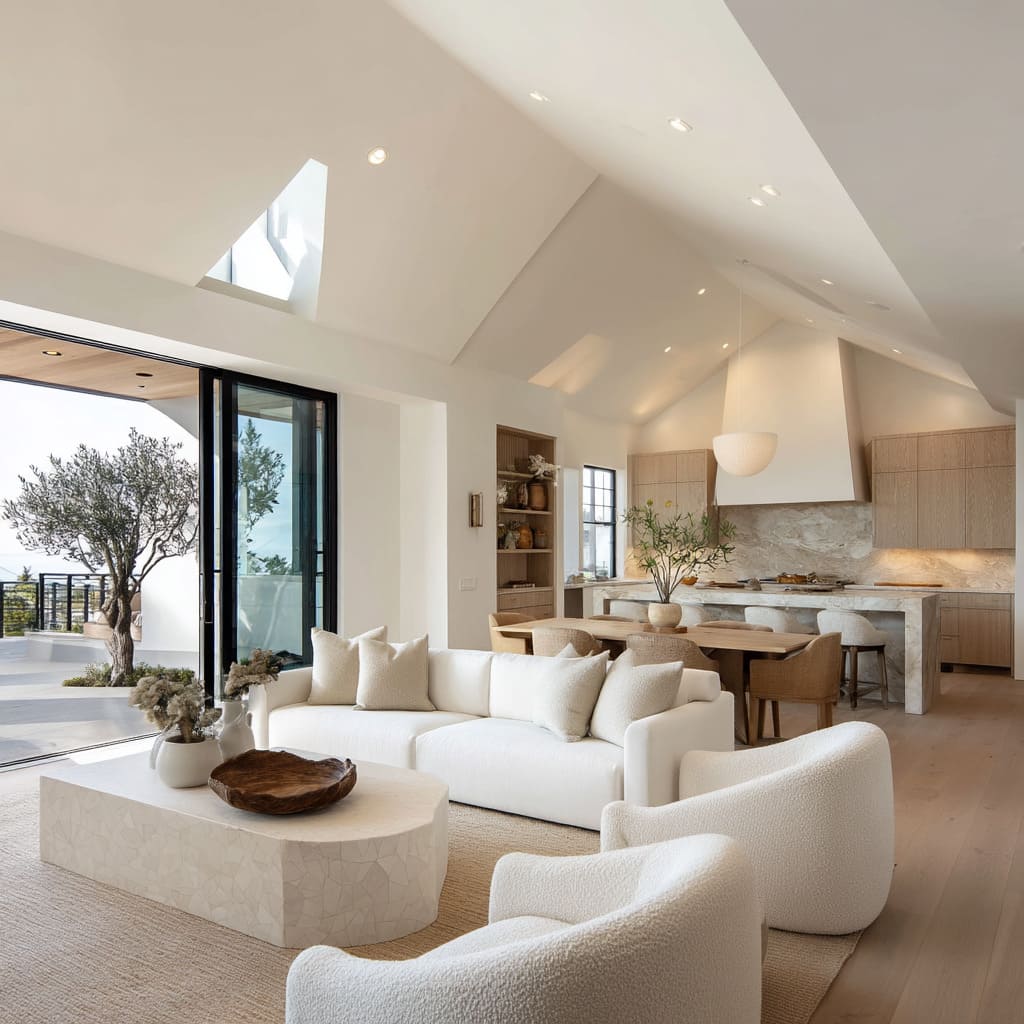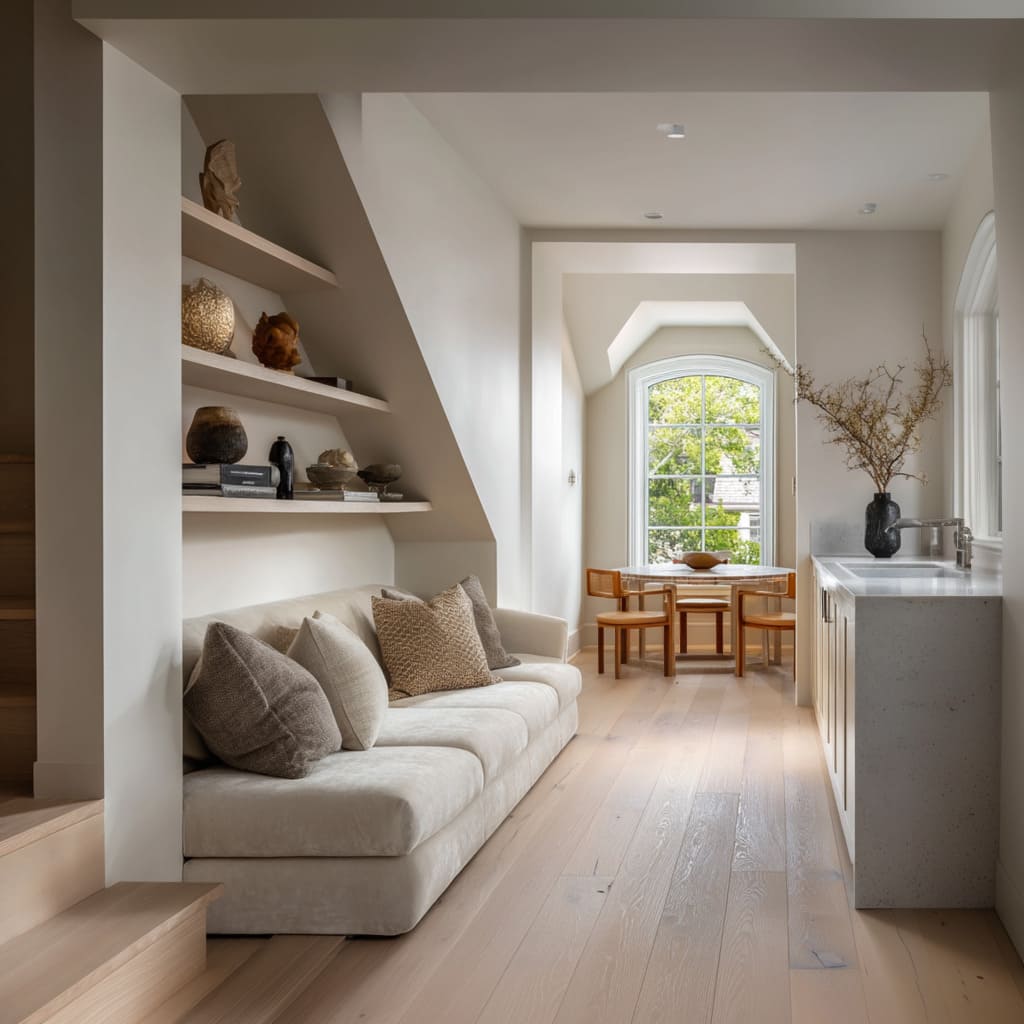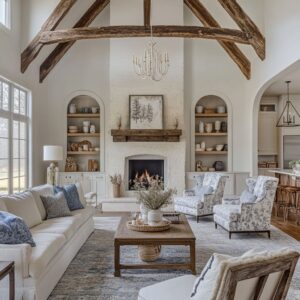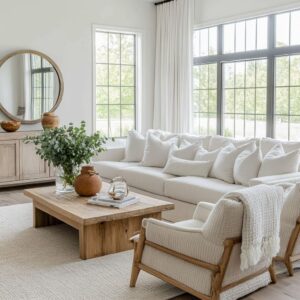There’s something about the quiet confidence of a coastal cottage that makes it linger in the mind. The spaces don’t rely on novelty or high drama—they build atmosphere through repetition, texture, and restraint.
Instead of leaning into predictable coastal themes, these interiors use shape, tone, and material in ways that feel collected over time. Nothing loud, nothing overworked.
Just small decisions layered slowly, until the room feels held together by light, air, and calm proportions.
In many of today’s small beach homes, that kind of thinking has evolved into something even more refined. What once felt purely nostalgic now feels structured without being stiff, airy without being vacant.
Pale woods, low-sheen surfaces, sculptural lighting, and curved seating forms take center stage—not to impress, but to settle into the rhythm of the room. These are the kinds of spaces where a shift in floor level does more than a wall ever could, and where a matte limestone table carries more weight than any high-gloss feature wall.
This article takes a closer look at the visual tools shaping that mood—how ceiling boards pull the eye, how benches cut through vertical space, and how even the absence of clutter reads as a deliberate layer. Whether working through new concepts or revisiting classic small beach house decorating ideas, the emphasis remains steady: make quiet choices that stay with you.
Ceilings That Lead the Eye Rather Than Simply Cover Space
In many beach cottage interiors, the ceiling carries as much visual weight as the walls—sometimes even more. It doesn’t simply cap the room but stretches it, guides the gaze, and sets the pace for how the space breathes.
A common feature is the use of long, uninterrupted boards running in a single direction, often vertically across vaulted planes. This arrangement draws from outdoor inspiration, like the worn lines of a boardwalk or weathered fencing near the dunes.
The boards don’t just look natural—they introduce rhythm, leading the eye toward a view, a beam, or the soft meeting point between wood and light.
Overhead, beams are often left in a pale washed finish. Some take on a sun-bleached driftwood look, while others lean into lime-toned warmth, always quiet in tone but rich in grain.
They hover above the planked surfaces like a softened framework—neither rustic nor overly polished—offering dimension without interruption. What makes these ceilings especially effective in coastal cottage interior design is their ability to shift throughout the day.
The lines and spacing allow natural light to trace through slowly, casting fine shadows that subtly shift position as daylight moves. It’s an effect that keeps the room in quiet motion, without needing any mechanical trick or artificial glow.
There’s a natural kind of theater at play—one built from nothing more than material, direction, and patience.
Repeating Curves: How Arcs Whisper “Water”
A coastal cottage doesn’t rely on obvious sea-themed décor to feel tied to the shore. Instead, many of the most refined rooms use a quiet repetition of curved shapes to suggest the ebb and flow of the coast.
These arcs appear in modest forms—arched windows, rounded doorways, and gently curved niche shelves—not as statement gestures, but as soft reminders of water’s presence. The repetition is never loud.
It’s placed where it belongs structurally, such as the gentle bend of a built-in bench under a window or the arch above a recessed fireplace. These shapes echo the horizon and the rhythm of waves without needing literal translation.
This approach offers a softer language within the architecture itself, letting squared-off furniture and grounded forms remain stable without dulling the space. The mix of shapes works especially well in homes where the ceilings soar or wall surfaces are expansive—introducing motion that feels natural rather than decorative.
Rounded lines provide a gentle break from the straight edges of cabinetry or built-ins, while also tying different areas of the room together without walls or screens. In many beach cottage interior spaces, that balance—between curve and line, between openness and suggestion—is what gives the design its lasting presence.
Tone-on-Tone Palettes That Still Feel Layered
Within coastal cottage interiors, color rarely announces itself outright. These rooms rely on subtle gradation rather than contrast, letting closely related tones share space in ways that feel quietly complex.
A room may begin with pale oat-colored walls and then invite tones like fog-washed blue, muted driftwood beige, or soft chalk white—each one sitting close to the next, never competing. What happens in this arrangement is more atmospheric than graphic.
The transitions feel like light passing through sheer fabric rather than brushstrokes on a canvas.
Instead of reaching for high contrast or bold hues, the palette often steps down gently in tone—creamy whites against bone, then bone into sand, then sand into soft sage or dusty blue. The effect isn’t washed out; it’s shaded, layered.
In a space like this, a single dark ceramic bowl or even a window view—especially one filled with pine, palms, or salt-worn fencing—becomes the strongest point of contrast. That’s the rhythm at play here: let the quiet tones build the mood, and let the natural world outside do the rest.
In this approach, nothing is forced to compete for attention. Every element has space to breathe without ever needing to be loud.
This style of tonal restraint is especially effective in spaces where texture and shape are already doing a lot. It’s one of the defining features of thoughtful coastal cottage style decorating: how light interacts with surface and how mood is shaped not by color saturation but by how nearby tones hum beside each other.
Texture Ordered From Softest Glow to Roughest Grain
There’s an unspoken sequence to texture in these spaces—one that draws the eye from soft to solid in a natural drift. Across coastal cottage interiors, textures are layered in a way that makes the room feel balanced without looking deliberate.
Smooth, matte-painted walls set the base tone. Next come the soft, brushed woods—sometimes bleached, sometimes muted by time—that bring warmth without glare.
Woven fibers follow: jute, linen, bouclé, open-cane backs. These sit lightly in the space, catching just enough shadow to stay visible without taking over.
Then, at the base of the arrangement—or often right at its center—comes something heavier. A limestone hearth.
A pale rock mosaic. A rough-edged coffee table carved from a single slab.
These stone elements are bold in material but quiet in tone, and they hold the room like anchors. Their presence feels earned because the textures that came before them softened the path.
The transition from matte paint to raw stone is paced so that it feels inevitable. It’s this texture sequence that gives the room a kind of internal rhythm.
Everything that touches the hand or catches the light has its place. The roughest elements don’t feel out of place because the materials before them paved the way.
That’s the art of it—how one surface leads to another, and how the balance stays intact even when weighty materials are introduced.
Integrated Storage Treated Like Low-Key Galleries
Storage in many coastal cottage rooms doesn’t act like conventional shelving—it feels more like a quiet showcase. Built-ins are shaped into the bones of the room: wrapping around fireplace walls, tucking beneath staircases, or framing deep window reveals.
But these shelves don’t overflow. Their strength comes from space as much as from what’s placed on them.
Items like driftwood, salt-bleached pottery, or weathered novels sit with breathing room between them, so nothing feels crowded and nothing competes. What gives these storage features their distinctive character is restraint.
The negative space becomes part of the look, offering contrast between surfaces and giving objects a chance to cast subtle shadows on surrounding wood or plaster. Lighting is rarely prominent—tiny sconces, recessed LEDs, or even the natural arc of a window provide just enough illumination to highlight texture.
The shelves feel like they’ve grown out of the space rather than been installed onto it, a feeling especially visible in coastal rooms where shelving forms blend with wall paneling or disappear into quiet tones. This kind of approach works especially well in compact homes, where function is essential but form is never ignored.
For small beach cottage interior design, it’s an example of how storage can add visual calm instead of clutter. A single ceramic bowl on a wide, pale shelf speaks louder than a stack of objects squeezed into view.
Window Benches as Horizontal Counterparts to Vaulted Height
In a room with soaring ceilings or an open vertical sweep, one of the smartest ways to anchor the volume is to add something long, low, and steady along the base of the wall. The window bench, common in coastal spaces, does exactly that.
Stretched beneath a wide frame or an arched inset, this built-in element works as furniture, storage, and architectural rhythm all in one. The effect is subtle but powerful—it holds the wall down.
Tall glass might lift the eye upward, but the bench leads it sideways, reminding the room to stay grounded. Its surface becomes a landing place for pale cushions, raw linen bolsters, or textured throw blankets in seafoam and sunbleached sand tones.
There’s a softness here that balances out the vertical drama above.
The bench isn’t only for sitting; it holds sunlight across its top, breaks up the distance between floor and ceiling, and frames whatever scene lies beyond the window. In many cottages, especially those with tight layouts, it also carves out storage within—hinged compartments or deep drawers hidden beneath the cushions.
This quiet feature often becomes the most used surface in the room. Whether in coastal Maine, parts of the Carolinas, or sunlit corners of the Pacific shoreline, benches under windows have become an iconic gesture in decorating a small beach cottage—where utility and comfort share the same footprint.
Furniture Massing: Rounded Forms Break Up Rectangles
Inside these coastal cottage rooms, most of the architecture remains faithful to strong lines—paneling runs in vertical planks, windows are square or arched, shelving sits in clean, measured grids. But the furnishings?
They curve. This contrast adds a softness that doesn’t need decoration to be felt.
Chairs with rounded backs, ottomans in plump silhouettes, coffee tables that appear carved from worn stone—all of these elements function like gentle punctuation marks within the square rhythm of the structure. The rounded edges serve more than just visual balance.
They create looseness in how furniture relates to the room. Corners don’t align perfectly; instead, slight offsets allow natural light to slip into unexpected spaces, where it pools across floorboards and throws soft shapes onto nearby surfaces.
The forms don’t interrupt—they smooth out the layout, much like coastal rocks polished by years of tide.
This layering of shape is especially important where square footage is tight. In smaller cottages, curved furniture creates subtle movement and eases the visual weight of heavier pieces.
The effect is felt even more strongly in open layouts, where rounded massing helps break up long sightlines and creates separation without requiring walls or barriers. These curved forms continue to shape many beach cottage furniture ideas today—less for their trend value, more for how naturally they sit within a space that wants to feel slow and sunlit.
Fireplaces as Sculptures, Not Just Heat Sources
In these coastal interiors, fireplaces hold the room—yet not always through fire itself. The shapes, materials, and surface treatments often turn the hearth into a sculptural statement, even when the flame is off.
Plaster forms sweep outward in smooth curves, limestone facades reveal embedded shells or mineral specks, and stacked stone surrounds feel chiseled from seaside cliffs. The fireplace becomes the central visual anchor, one that leans into texture and contour more than any overt styling.
The firebox may be deliberately underplayed—set lower to the floor, trimmed in black, or kept modest in scale—so that what surrounds it becomes the real point of interest. A raised hearth in cool stone, or a mantle with no shelf at all, lets light move freely across the face of the material.
In some cottages, the texture alone creates rhythm: plaster catching morning sun with soft ripple, stone casting grainy shadow in the evening. Even in warmer climates or summer-heavy homes, where the fireplace is rarely used, the structure still carries weight.
It centers the furniture, sets the tone, and provides a contrast to the otherwise soft palette of coastal living. It’s one of the more understated but deeply effective decorating ideas for a small beach cottage—an architectural gesture that’s part sculpture, part function, and completely tied to place.
Low-Gloss Stone Tables: A Lesson in Quiet Authority
There’s a particular presence that certain materials bring when they don’t try to shine. In many beach cottage interiors, coffee tables made of limestone, marble, or sandstone step into the center of the room with a kind of stillness.
These surfaces aren’t polished to a mirror. Instead, they hold a honed, almost chalky softness that diffuses light rather than bouncing it.
What results is a table that feels grounded without commanding too much attention—its form is firm, but its finish stays out of the spotlight.
You’ll often find these pieces resting on thick plinths or square-cut legs that lift them just enough to allow a slice of shadow underneath. This subtle elevation keeps them from feeling heavy, even when the material itself has considerable weight.
In some rooms, the top appears almost floating—edged in softened corners and paired with delicate textures nearby like boucle upholstery or a fine jute rug. These combinations are no accident.
They allow the stone to speak through texture rather than shine, drawing the eye to depth and shadow rather than gloss and glare. The charm lies in how the table works with everything around it.
It acts as the room’s anchor, allowing lighter elements to drift nearby. Within many beach cottage decorating ideas, it’s one of the strongest centerpieces—not because it’s loud, but because it knows how to stay quiet.
Lighting That Trades Sparkle for Shadow Play
Lighting in coastal spaces rarely aims to dazzle. Instead, it prefers to scatter and soften.
Rather than shining directly down or gleaming with polish, fixtures here often filter light through texture—creating pattern, movement, and warmth across ceilings and walls. A loosely woven rattan globe might leave behind a subtle shadow grid.
Beaded domes cast soft halos. Even a linen drum shade, with its layered weave, breaks up the beam into something gentler and more varied.
The approach draws from everyday coastal elements. Think of how sun slips between slats on a boardwalk or moves through a basket weave left on a porch.
The goal is less about clarity and more about rhythm—light that moves across space rather than lands in one spot. In many homes, even the more structured lighting, like track beams, is treated with quiet intent: painted in muted tones, tucked into ceiling lines, or aimed carefully to highlight a shelf rather than a centerline.
What makes this approach feel so cohesive is how well it ties back to the materials used in the rest of the room—wood, plaster, fiber, stone. There’s rarely a high-gloss finish in sight.
Every beam of light reacts to grain, surface, or subtle unevenness, becoming part of the design rather than something added on top. This soft diffusion of light has become a defining feature of beach cottage interior design—it doesn’t spotlight, it surrounds.
Art and Objects: Coastal Motifs by Suggestion
In the most thoughtful coastal interiors, visual art rarely announces itself with force. It whispers through muted tones, natural textures, and the simplest gestures—never relying on literal iconography.
An abstract canvas in pale, ocean-washed hues might hang quietly above a mantel, echoing the suggestion of horizon lines without needing to spell them out. Dried branches, gathered shells in matte bowls, or softly aged vessels often take the place of framed artwork altogether.
These elements function less as decoration and more as memory—found, placed, and left undisturbed.
Repetition plays a role here too. Three ceramic jugs, nearly identical but with small imperfections.
A low stack of drift-colored books beside a stone fragment on an open shelf. Together, they build presence without noise.
They feel part of the room rather than placed into it. That’s what sets them apart from obvious themed décor.
There’s no clamoring for attention—just one tone responding to another. Scroll through any curated collection of coastal cottage decorating pictures, and you’ll likely find this approach in action.
Art, in these spaces, isn’t treated as a focal point—it’s handled as a thread that connects color, shape, and surface. Whether a sculptural object or a sea-toned painting, what matters most is the quiet way it holds its place.
Sub-Zones Defined by Floor Level or Surface Shift
The subtle organization of space is one of the more clever qualities found across modern coastal cottages. Instead of walls or heavy partitions, rooms often shift their purpose through a slight change in floor height or surface material.
A single step can transition a sitting area into a kitchen nook. A woven ottoman can stand in for a central coffee table, signaling conversation space rather than circulation.
These soft cues allow for definition without disruption.
By moving through these small gestures—rather than fixed barriers—a home maintains openness while still guiding movement. Zones emerge naturally.
A slight rise in floor plank direction, a rug shift, or a step up at the back of a lounge—all these tactics say, “here’s where this begins” without ever saying, “here’s where that ends. ” It’s a technique that feels effortless but holds deep intention.
This works especially well in tight footprints, where square footage needs to stretch visually. Each material shift or level change creates pause without stopping the eye.
It’s one of those elements that doesn’t scream design decision, yet it frames the entire experience. Many modern beach house decorating ideas lean on this quiet restructuring—offering rooms that are open, yet quietly understood.
Key Takeaway: Where the Light Touch Matters Most
The most striking spaces aren’t always those filled with standout pieces or high contrast. In the world of coastal cottages, the beauty often lies in restraint—a color held back half a tone, a texture allowed to fray slightly, a curve used not to decorate but to shape the way a room feels.
These homes don’t feel staged. They feel settled.
The furniture doesn’t dominate; it settles into soft placement. The beams don’t shout; they mark quiet rhythm above.
Every move is one layer deep—not louder, not bolder. A matte surface over gloss.
A built-in bench instead of a bulky couch. A shadow shifting on a wall instead of a spotlight.
These choices add up, not in volume but in atmosphere. And that’s where the design holds its strength—not in what’s obvious, but in how things are left slightly undone, slightly textured, slightly softened by air and time.
That gentle approach is what defines the most lasting coastal rooms. Not as a style to copy, but as a mindset that sees space as something to be lived with, not displayed.
